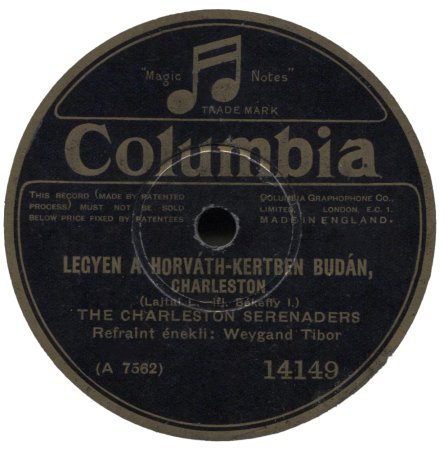
“Ne félj a csóktól babám” (“Don’t be afraid of kisses, baby”)
The Charleston Serenaders; Weygand Tibor, vocal
(Columbia 14149 mx WA 7561) circa June 27, 1928
“Legyen a Horváth-kertben Budán” (“Be in the Horváth Garden in Buda”)
The Charleston Serenaders; Weygand Tibor, vocal
(Columbia 14149 mx WA 7562) circa June 27, 1928
Here’s a record from the Edward Mitchell collection featuring two recordings by a popular 1920s and 1930s Hungarian vocalist and film star backed up by a nice, somewhat jazzy dance band.
Both of these songs were written by Lajos Lajtai and István Békeffy for the 1928 Hungarian operetta A régi nyár (The Old Summer). In early 20th-century Europe, operettas were the source of many songs performed by jazz and dance bands in the same way that Broadway musicals were in the United States. This particular operetta was also made into a 1942 Hungarian film.
“Legyen a Horváth-kertben Budán” (“Be in the Horváth Garden in Buda”) refers to a famous and historic park in Budapest. The song has a definite Eastern European flair.
The band’s arrangement on “Ne félj a csóktól babám” (“Don’t be afraid of kisses, baby”) reminds me a bit of the sort of music played in the musical revues in German cabarets during the era.
Tibor Wegand was one of Hungary’s more popular male vocalists in the 1920s and 1930s and appeared in several Hungarian films. You can view a nice clip of him singing a very catchy song in one such film from 1936 on this YouTube video.
There is contradictory information as to when and where these recordings were made.
The Grammophon Portal website lists the recordings as having been made in Vienna in 1929. The Austrian-based Society for Historical Sound Recordings website lists them as having been made in Vienna in 1928.
However, other sources state that they were recorded in London in 1928. I am strongly inclined to believe this to be the case.
WA matrix number prefix that appears in the runout groove on both sides of the record was primarily used by UK Columbia for recordings that were made in Britain.
Furthermore, since matrix numbers were issued consecutive order, WA 7561 and WA 7562 would have been assigned in late June, 1928. By January 1929, the WA matrix numbers were up to WA-8275.
Under the “Charleston Serenaders” listing in his British Dance Bands On Record 1911-1945 Brian Rust states:
“Pseudonym on Columbia for Van Phillips and his Band, q.v., and for various American bands also.”
At the end of his listings for the Van Phillips band, Rust states the following:
“A considerable number of sides were made in 1928 and 1929 by a studio orchestra that seems to have included Van Phillips, under the nominal direction of Stan
Greening; but all were of material designed for Continental issue, in languages
such as French, German, Danish and Hungarian, with many vocals in those languages. In view of the enormous number of these, and of their not having been issued in the UK, – we feel it is better to exclude them as being outside the scope of this book.”
I think it is most likely that the recordings here were part of the above-mentioned sides.
A bit of further circumstantial evidence can be found under Rust’s section for Stan Greening’s band for a June 27, 1928 London recording session that produced a recording of “Mississippi Mud” that ended up not being issued. The matrix number assigned to that recording was WA-7563 – just one digit higher than the matrix numbers for the recordings here.
Given that matrix numbers were issued consecutively and the previously mentioned connection between Greening and the Charleston Serenaders pseudonym, that suggests a very strong likelihood that the recordings here were part of that same June 27, 1928 recording session. That is also what I used as the basis for the estimated recording date.
